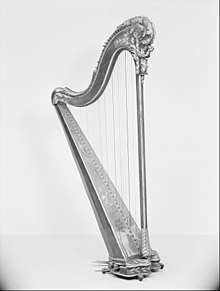Jean-Henri Naderman
| Jean-Henri Naderman | |
|---|---|
| Born |
1734 Germany |
| Origin | France |
| Died | 1799 (aged 64–65) |
| Occupation(s) | Harp maker, publisher |

Jean-Henri Naderman (baptised 20 July 1734 – 4 February 1799) was one of the leading harp-makers in Paris in the 18th century, and also a music publisher. He supplied the Royal Household with his instruments and wrote his music in classical style, with a large influence of the baroque. He had two sons, François Joseph Naderman, renowned harpist, and Henri Naderman, harp maker.
Life
Jean-Henri Naderman was baptised (and presumably born) in Lichtenau in the archdiocese of Paderborn,[1] but emigrated to France around 1756 where he began working as a harp manufacturer. Later in 1777 he was licensed to work as a music publisher.[2] He rose to fame when he was commissioned to create and perfect the harps of Queen Marie-Antoinette on her arrival in France, together with the Czech composer and harpist Jean-Baptiste Krumpholtz.
The Naderman single-pedal harp is supposed to have been modelled after the successful eighteenth-century Bavarian single-action mechanism pedal harp, whose manufacture, although claimed by several other harp makers including Jean Paul Vetter of Nuremberg and Johann Hausen of Weimar,[3] is often attributed to Jacob Hochbrucker.[2] Today, six harps of this specific model have been located.[4] Jean-Henri Naderman died in Paris.
Works
- Petite chasse
- Sonate op. 17 no.2 in F major (harp solo)
- 12 Études et un thème varié (harp solo)
References
- ↑ Droysen-Reber, Doris: "Naderman Familie", in: Die Musik in Geschichte und Gegenwart (MGG), supplement volume (Kassel: Bärenreiter, 2008), cc. 597–8.
- 1 2 Wenonah Milton, Govea (1995). Nineteenth- and twentieth-century harpists: a bio-critical sourcebook. Greenwood Publishing Group. p. 207. ISBN 0-313-27866-0.
- ↑ Wolf, Beat. "Pedal Harp Jakob Hochbrucker, Donauworth, 1728" (PDF). Beatwolf.ch. Retrieved 11 August 2011.
- ↑ Institut de recherche sur le patrimoine musical en France. "Écoles et traditions régionales (2e partie)". IRPMF. Retrieved 11 August 2011.
- Attribution
- This article is based on the translation of the corresponding article of the Russian Wikipedia. A list of contributors can be found there at the History section.
External links
- Ornately Decorated Harp by Naderman, 1797 on the National Music Museum - University of South Dakota.